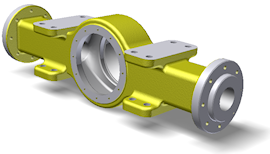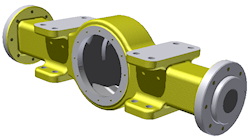To Display Shadows in Model View
Use Shadows to provide a better sense of volume and positioning.
Apply Shadows to Model Views
On the ribbon View tab
 Appearance panel, expand the Shadows list, and select shadows to display:
Appearance panel, expand the Shadows list, and select shadows to display:All Shadows displays shadow effects for all visible scene objects.
Shaded visual style with all shadows turned on.

Ground Shadows casts a model shadow onto the ground plane. Does not require the ground plane to be visible.
Shaded visual style with only ground shadows turned on.

Object Shadows sometimes called self-shadows. Casts and receives model shadows based on the position of the active lighting style.
Shaded visual style with only object shadows turned on.

Ambient Shadows casts shadows in corners and cavities to visually enhance the transition of shape changes.
Shaded visual style with only ambient shadows turned on.

Shaded visual style with no shadow effects turned on.

Modify the Document Shadow Settings
- On the ribbon View tab
 Appearance panel, Expand the Shadows list, and click
Appearance panel, Expand the Shadows list, and click  Settings.
Settings. - In the Lighting Styles dialog, on the Shadow tab, adjust desired settings for shadow density, softness and the presence of ambient shadows.
- Click Save and Close.
 Styles and Standards panel
Styles and Standards panel Styles Editor click the Shadows tab. Shadow settings, Density, Ambient Shadows, and Softness work with Directional Lighting styles. Softness works with Environment Lighting Styles while Density and Ambient Shadows are derived from the environment image.
Styles Editor click the Shadows tab. Shadow settings, Density, Ambient Shadows, and Softness work with Directional Lighting styles. Softness works with Environment Lighting Styles while Density and Ambient Shadows are derived from the environment image.